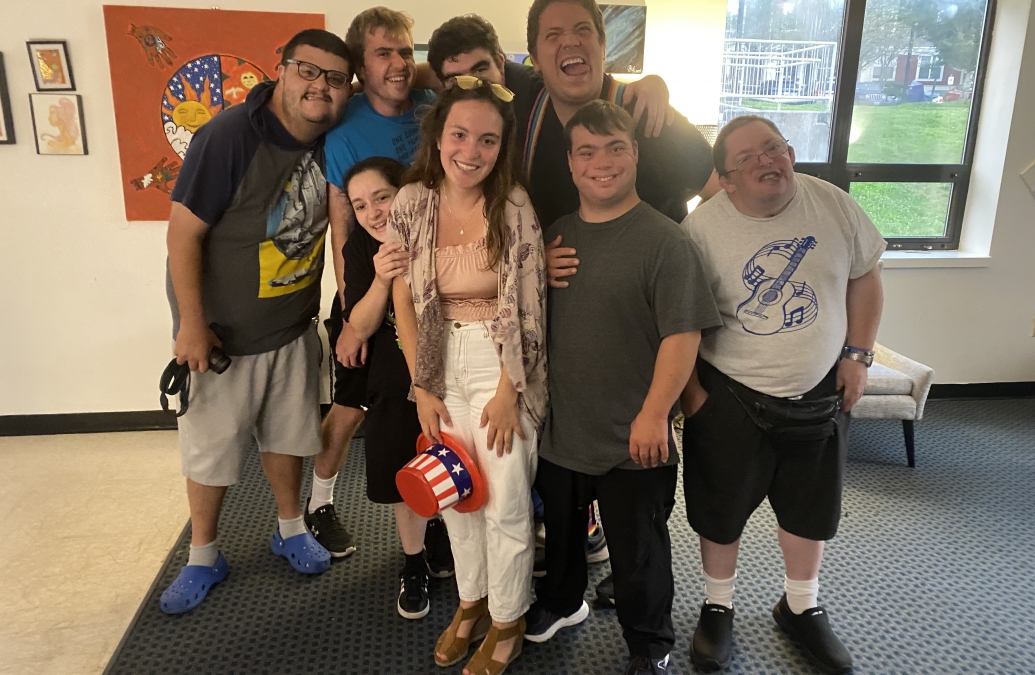Swearer Storyteller reflects on community engagement experience

Maya Laur '24 with 134 Collaborative community members
Maya Laur ’24, Swearer Center Storyteller and Community-Based Learning and Research (CBLR) Fellow, is also pursuing the Engaged Scholarship Certificate as a Modern Culture and Media Studies concentrates. Laur shares her academic and personal experience engaging through the Swearer Center, reflecting on opportunities that allowed her to put her studies of multidisciplinary art forms into practice for social good. The Storytellers program allows Brown University students to participate in community storytelling benefiting Providence and Rhode Island communities. For her project, Laur wrote about 134 Collaborative, a secular nonprofit that operates in the building of Mathewson St. Methodist Church. Laur illustrates her experience through two written pieces: a poem titled “Summer on York St”. and a creative profile titled “Miracle on (1)34th." Learn more about her community engagement work and academic journey in our full feature.
Miracle on (1)34th.
From the street view, the church on 134 Mathewson St. might seem like any other place of worship. There’s a black and white church sign that’s been around since the 50s. A cross resting next to a set of stained glass windows. A streetlamp caked with snow and silt from cars that don’t slow down for pedestrians. And a couple of bicycles propped up against an aluminum railing. But step inside, and you’ll find a little Narnia nestled between Weybosset Street and Kennedy Plaza: 134 Collaborative, a secular nonprofit that operates in the building of Mathewson St. Methodist Church.
In the breezeway, you’ll see 134 volunteers, Joel and Anya, sorting through sweetcorn and apples from the local farmer’s market. Donna is there, next to them, handing out winter coats to friends she knew in the days before she had housing. They wave to the woman walking in with the polka dot pants and the dog in a purse. The regular with the Carhartt jacket and tireless smile. The kid still in his pajamas. Sometimes, there are flowers and bus passes. And, last month, Donna brought her puppy.
In the dining room, people are gathering to talk and eat and catch a break from the cold. Old timers with salt-and-pepper beards and stories from protests back in the Paolino days. Veterans who speak only in Spanish. Hippies with braided hair and buttons from Occupy Wall Street Providence. Poets, musicians, mathematicians, and pastors. And people whose entire lives fit into a single shopping bag.
In the Gallery, the Tenderloin Opera Company sings to the paper mache puppets that line the far wall. Old songs, about hope and rivers and Chinese restaurants. Last month, this space was a flu clinic. The week before, a legal clinic. Now, the room is full of suns and moons. Donkeys and goddesses and one-eyed cyclops’. They listen as the company members laugh about aging backs and old friends and swap pictures of pets and grandchildren. As the air fills with song and resin and stardust. “When I was still on the streets, there are some people out there who might have been embarrassed to have me in their house,” a TOC veteran tells the groups’ leaders. “But you guys never were.”
Upstairs, Saul sifts through data from the RIPTA bus surveys he’s collected. The buses are too crowded, people have said. And, sometimes, they don’t slow down enough when you’re trying to get on. But he’s determined to fix it. And he won’t take no for an answer. On the third floor, unhoused journalists write articles on the Charles St. Eviction in Street Sights Newspaper. In the basement, the members of Breakfast with Bill pray to the God in the sky or the church walls or maybe just the one in the backs of their pamphlets.
In the kitchen, Irene and Laura chop parsnips and celery as college students fill cup after cup with instant coffee. Laura still has stitches on her face from the week she was out for a septum surgery. But she’s back now and smiling and so they stew cranberries and pass jokes back and forth as the kitchen fills with rosemary and laughter and salt. “Jaila saved my life,” one of the church oldtimers likes to say.” She believed in me, even when no one else did.
Last October, 200 people packed into the dining hall to honor those who had lost their lives while homeless. Street artists, professors, non-profit directors, and people still waiting for housing shared prayers and pasta and hope for a better world. “If you see a homeless person on the street, just say hello,” Donna said, as volunteers handed out carnations and candles. “It may not mean much to you. But to know that people see you. To know that someone is paying attention. That can be the difference between life and death. A hello is a lifeline. A prophecy. A prayer.”
Then, in June, the fourth flour filled with wise robots, ghost bands, and a fisherman from the spirit realm. Stories from Tenderloin Opera Company’s Spring musical. Fifteen friends, singing in a Black Box Theater about drum circles, shelter closings, and family on the other side. Stories of poets and protests and people whose lives fit into single shopping bags. Stories that live on Mathewson St. Outside there were street sweeps and cold shoulder politics and cars that don’t slow down for pedestrians. But, inside, there was coffee and laughter and stardust. Inside, there was Irene, Jaila, Saul, Joel, and Anya. Inside there was magic.
Summer on York St.
In July the air was filled with salt and resin and stardust. A bucket of paint in the windowsill.
A bin of costumes in the corner.
There were paper mache galaxies
purple ballet shoes
and plays
scribbled on to pieces of notebook paper.
There were stand up comedy nights and clay puppet shows
and textile workshops.
At the end of the month, a man in his 20s stood at the front of the room and performed a musical he’d written on the spot 20 minutes earlier. No lights.
No scene partners.
Just laughter
and beat drops
and a single mickey mouse hat.
Then winter came,
and the costumes went back in the closet and the clay dried up
and the audiences went home.
But the paint stayed on the windowsills.
And the resin stuck to the tables.
And long after the sea had turned gray and icy, she sat in that Newport classroom
and leafed through old notebooks
and watched as the stardust settled on the floor. It was summer.
She thought.
The artists were here.
